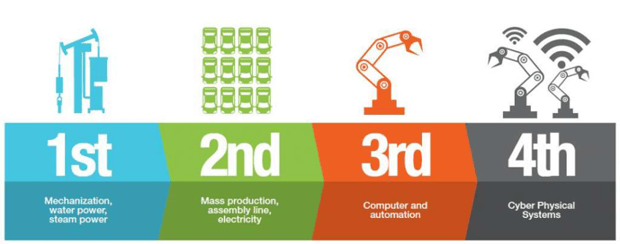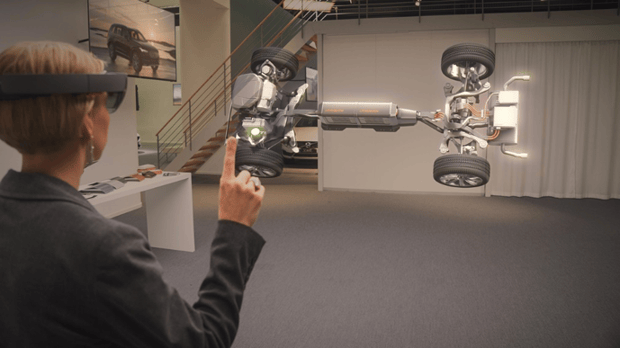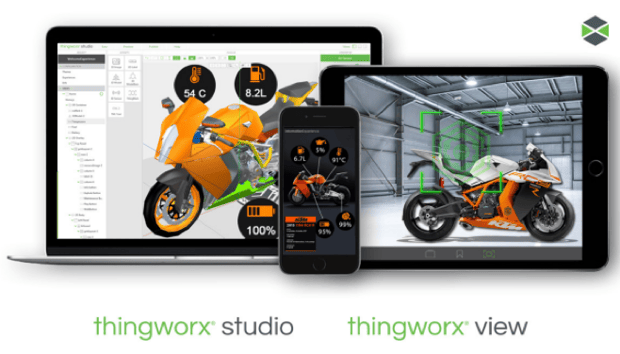
Humanity is evolving with its surroundings. The interaction between the made world and how it evolves with humans is becoming more synchronous.
We are entering a period where binary input and output is replaced by more fluid transitions of data. The tools using this data work more intelligently for any given goal.
PTC and many other companies are calling this Industrial Revolution 4.0.
Are we SMART?
The word smart can mean lots of things. We try and work smart. We are surrounded by smart products, and we work with smart peers. So what exactly is a smart world and how do we measure it?

PTC’s vision of integrating smart products to utilise IoT and the AR \ VR technology which PTC had acquired through Vuforia was first introduced to me at Warwick University during the Develop3D show in 2016.
The scenario – A sensor on a motorbike informs its rider that something is wrong via a “smart” connection to an IoT mashup dashboard. Nothing too ground-breaking, I’m sure you would agree. However the story doesn’t end here.
The next step is to point the tablet (or whatever device you are using to connect to the bike) and locate the ThingMark. You tell the tablet that you wish to carry out a repair and by locating the marker, the tablet superimposes a CAD model over the top of the real bike via the camera of your tablet. It then gives you the appropriate instructions to disassemble the bike which include interactive animations. Once you have followed the instructions and carried out the physical work, you communicate through the tablet to the bike to carry out a sensor reset and to confirm you have fixed the issue – all without expert technical knowledge (providing you can use some basic tools). Job done.
How is this smart? To recap, an unskilled operator has identified an issue, carried out necessary physical work and confirmed the issue as resolved. This is smart. Now take out the tablet and replace with Microsoft HoloLens and you have a workforce which is quite formidable. Information is given to the user optically leaving their hands free to carry out the work.
I have some fond memories of crawling underneath my dad’s old Land Rover but there’s no denying this technology would have made it a whole lot simpler, saving time and effort (and scratching of heads looking at the Haynes manual – if you’re under 30, Google this).
ThingWorx Studio
PTC has introduced augmented reality in Creo Parametric 4.0. Users have the ability to create experiences out of the box.

It’s incredible (and lots of fun).
However, to really make useful experiences like the one described earlier, ThingWorx Studio can provide a user friendly environment where interactive experiences can be quickly generated.
The really smart aspect is that companies can re-use CAD data generated during design and development – there is no need to produce new data. This has benefits such as changes and developments in the design propagating through to experiences created. And it’s not just limited to native Creo CAD data; the software can also support non-native formats such as STEP and IGES.

PTC describe ThingWorx studio as Simple, Powerful and Scalable – it leverages current design tools and provides a virtually codeless environment accessible via a web browser. The software has been designed to seamlessly link with other IoT objects making the whole experience simple. Where PTC have been smart is their decision to acquire technology from market leaders to develop an inclusive suite which provides a broad spectrum of possibilities.
Final Thoughts
This technology is emerging. The real question of how successful smart technology can be should actually be how smart humanity is at using this technology. The tools have now been provided to augment virtual data into our “real” world and this is pretty cool stuff but how will businesses benefit?
Smart integrated products (which give constant feedback) enhance the user experience; smart manufacturing streamlines production and ensures efficiency and low costs. The benefits are endless only limited by imagination. Personally, I’m very excited to be part of the new industrial revolution, 4.0.